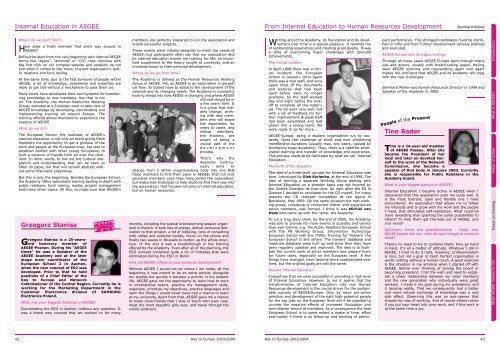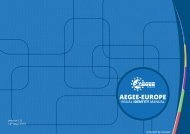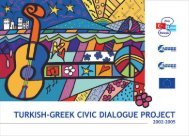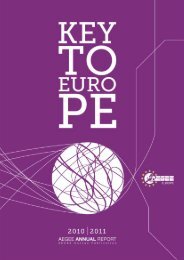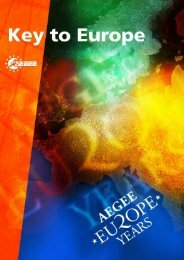Key 2003/2004 - AEGEE Europe
Key 2003/2004 - AEGEE Europe
Key 2003/2004 - AEGEE Europe
You also want an ePaper? Increase the reach of your titles
YUMPU automatically turns print PDFs into web optimized ePapers that Google loves.
Internal Education in <strong>AEGEE</strong>From Internal Education to Human Resources DevelopmentBernhard MüllerWhere do we start from?ow does a fresh member find one’s way around inH<strong>AEGEE</strong>?Difficulties start from the very beginning with internal <strong>AEGEE</strong>terms like "Agora", "antenna" or "CD", they continue withthe first click on our complex website and certainly do notend when it comes to the 'hows' of event organisation, publicrelations and fund raising.At the same time, due to the fast turnover of people within<strong>AEGEE</strong>, a lot of knowledge, experience and expertise arelikely to get lost without a mechanism to pass them on.Many locals have developed their own systems for transferringknowledge to new members, but that is notall. The Academy, the Human Resources WorkingGroup, operates at a <strong>Europe</strong>an level to take care of<strong>AEGEE</strong> knowledge by developing, coordinating andimplementing training all around <strong>Europe</strong>. Thetraining offered allows members to experience theessence of <strong>AEGEE</strong>.What do we do?The <strong>Europe</strong>an School, the mainstay of <strong>AEGEE</strong>'sinternal education, is not only an event giving freshmembers the opportunity to get a glimpse of thework and people at the <strong>Europe</strong>an level, but also toestablish contact with other young <strong>Europe</strong>ans, tobuilt a network of friends from all over the continent.In other words, to live out the cultural integrationand understanding that can be seen sooften on paper, but that will remain abstract withoutsome first-hand experience.But this is only the beginning. Besides the <strong>Europe</strong>an School,the Academy offers specialised training dealing in depth withpublic relations, fund raising, media, project managementand many other topics. All this, to make sure that <strong>AEGEE</strong>'sGrzegorz StaniszPeopleo f t h eP a s trzegorz Stanisz is a 25-years-honorary member ofGold<strong>AEGEE</strong>-Poznan. During his "<strong>AEGEE</strong>times" he was a Speaker of the<strong>AEGEE</strong> Academy and at the laterstage main coordinator of the<strong>Europe</strong>an School 2 in Aachen,when the new concept of ES2 wasdeveloped. Prior to that he heldpositions of a Chief Editor of the<strong>Key</strong> to <strong>Europe</strong> and NetworkCommissioner of the Central Region. Currently he isworking for the Marketing Department in theCustomer Electronics division of SAMSUNGElectronics Poland.What was your biggest challenge in <strong>AEGEE</strong>?Coordinating the ESII in Aachen, without any question. Itwas a brand new concept that we worked on for manymembers are perfectly prepared to run the association andcreate successful projects.These events were initially designed to meet the needs of<strong>AEGEE</strong>, but participants often say that our association andits internal education events are training for life, an importantsupplement to the theory taught at university, and animmense boost to their personal development.Where do we go from here?The Academy is defined as the Human Resources WorkingGroup of <strong>AEGEE</strong>. Yet, as <strong>AEGEE</strong> is an association in perpetualflow, its bodies have to adapt to the development of thenetwork and its changing needs. The Academy is constantlylooking ahead into how <strong>AEGEE</strong> is changing and where <strong>AEGEE</strong>will and should be ina few years' time. Itis a group that initiateschange, workingwith new memberswho will shapethe association foryears to come, andwhose members,the trainers, areaware of being acrucial part of thedevelopmentprocess.That's why theAcademy continuouslyaims tochange from a rather inward-looking body into one thathelps members to find their place in <strong>AEGEE</strong>; that not onlyeducates members once they have joined the association,but elaborates strategies to help students find their way intothe association; that focuses not only on internal education,but on human resources.months, including the special brainstorming session organizedin Munich. It took lots of energy, almost exclusive dedicationto that project, a bit of lobbying, tons of consultingwith oldies and external bodies, hours on the phone andfinally two weeks in Brussels to button up the whole structure.In the end it was a breakthrough in the trainingoffered by the Academy. Even after all of the planning, theESII concept contained quite a lot of mistakes that wereeliminated during the ESII in Berlin.How did <strong>AEGEE</strong> influence your personal development?Without <strong>AEGEE</strong> I would not be where I am today. At thebeginning it was meant to be an extra activity alongsidemy studies but quickly it became a priority in my studentlife. <strong>AEGEE</strong> gave me the opportunity to learn how to workin international teams, practice my management skills,negotiate, prioritise my objectives, practice languages andlearn the things I would never have had a chance to learnat my university. Apart from that, <strong>AEGEE</strong> gave me a chanceto make close friends that I stay in touch with even now,meet the most beautiful girls ever, and travel through thewhole continent.riting about the Academy, its foundation and its devel-over time is a special pleasure. It reminds meWopmentof outstanding experiences and meeting great people. It wasa time of overcoming major challenges with splendidachievements.The critical incidentIn April 1999 there was a criticalincident: the <strong>Europe</strong>anSchool in Giessen. Once againthere was a new staff, and onceagain most of the documentsand lectures that had beenused before were no longeravailable. So the staff workedday and night before the kickoffto complete all the materials.The ES went very well, butwith a lot of feedback for furtherimprovement. A great staffhad been assembled and hadgrown into a strong team. Wewere ready to go for more...<strong>AEGEE</strong>-<strong>Europe</strong>, being a student organization run by students,faces the challenge of short and ever shorteningmembership durations (usually max. two years, caused byshortening study durations). Thus, there is a need for acceleratedlearning and transfer of knowledge and experience.This process needs to be facilitated by what we call 'InternalEducation'.The birth of the AcademyThe idea of a three-level concept for Internal Education wasborn, introduced by Oleh Kyrienko, at the end of 1998. Theidea of forming a separate Working Group dealing withInternal Education on a steadier basis was not favored bythe Comité Directeur at that time. So right after the ES inGiessen I decided to candidate for the CD myself. For manyreasons the CD changed completely at the Agora inBarcelona, May 1999. On the same occasion the new workinggroup, consisting of renowned 'oldies' and experiencedactive members, was formed. I think it was Michiel vanHees who came up with the name: the Academy.To cut a long story short, by the end of 2000, the Academywas able to provide far more events in quantity and varietythan ever before, e.g. the Public Relations <strong>Europe</strong>an Schoolwith the PR Working Group, Information Technology<strong>Europe</strong>an School with the ITWG, Training for Trainers, the<strong>Europe</strong>an School II and others. The trainers' database andmaterials database were built up and since then they havebeen regularly updated and improved. The idea is to facilitatethe current work of active members and prepare themfor future tasks, especially on the <strong>Europe</strong>an level. A fewthings have changed, have become more sophisticated overtime, but the original goals are still the same.Beyond Internal EducationI would say that we were successful in providing a high levelof Internal Education. However, to me it seems that thetransformation of Internal Education into real HumanResources development is the crucial driver for the sustainablesuccess of <strong>AEGEE</strong>-<strong>Europe</strong>. Only by more pro-activeselection and development of the right high-potential peoplefor the top jobs on the <strong>Europe</strong>an level will it be possible tocounter the negative effects of increased fluctuation andever shorter tenure of members. As a consequence the best<strong>Europe</strong>an School is to some extent a waste of time, effortand money if there is no follow-up and tracking of participantperformance. The strongest candidates must be identifiedin time and their further development actively plannedand executed.<strong>AEGEE</strong>-<strong>Europe</strong> and its happy endingsThrough all these years <strong>AEGEE</strong>-<strong>Europe</strong> went through manyups and downs, usually with breath-taking speed. Havingseen <strong>AEGEE</strong> evolving and rejuvenating again and againmakes me confident that <strong>AEGEE</strong> and its Academy will copewith the new challenges.Bernhard Müller was Human Resources Director in 1999 andSpeaker of the Academy in 2000.Peopleof the PresentTine Baderine is a 24-year-old memberTof <strong>AEGEE</strong> Passau. After shebecame the President of herlocal and later on devoted herselfto the work of the NetworkCommission, she became aspeaker of that body in January <strong>2003</strong>. Currentlyshe is responsible for Public Relations in theAcademy board.What is your biggest passion in <strong>AEGEE</strong>?Internal Education! I became active in <strong>AEGEE</strong> when Idiscovered that this association suits me quite well. Itis the most tolerant, open and flexible one I haveencountered. An association that allows me to followmy interests and to grow with my work and the peopleI meet, that stimulates self-realisation. What could bemore rewarding than granting the same possibilities toothers? To help them get the best out of <strong>AEGEE</strong>, andvice versa?Optimism, smile and professionalism - that's how<strong>AEGEE</strong> people see you. How do you manage to combinethese?There's no need to try to combine them; they go handin hand. It's all a matter of attitude. Whatever I did in<strong>AEGEE</strong>, I tried to do it right, meaning: professionalismis nice, but not a goal in itself. Perfect organisation isworth nothing without a human touch. A good exampleis the situation in my antenna when I started off with<strong>AEGEE</strong>. Before ever thinking of joining the board orbecoming president, I felt the wish and need to establisha closer relationship between our older membersand the new generation who individually were greatworkers. I made it my goal during my presidency, andit became reality. That we consequently had a betterand more natural exchange of knowledge was a niceside effect. Observing this was an eye-opener thatshaped my way of working. And of course others noticeif you put your heart into your work, and if this work isat the same time a joy.What <strong>AEGEE</strong> means to me Focus on training Fields of action What is <strong>AEGEE</strong>? Introduction42 <strong>Key</strong> to <strong>Europe</strong> <strong>2003</strong>/<strong>2004</strong><strong>Key</strong> to <strong>Europe</strong> <strong>2003</strong>/<strong>2004</strong>43


